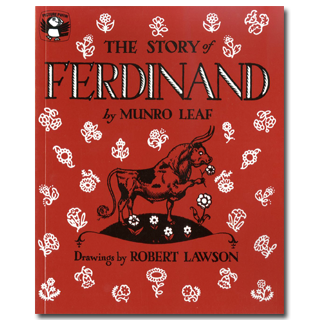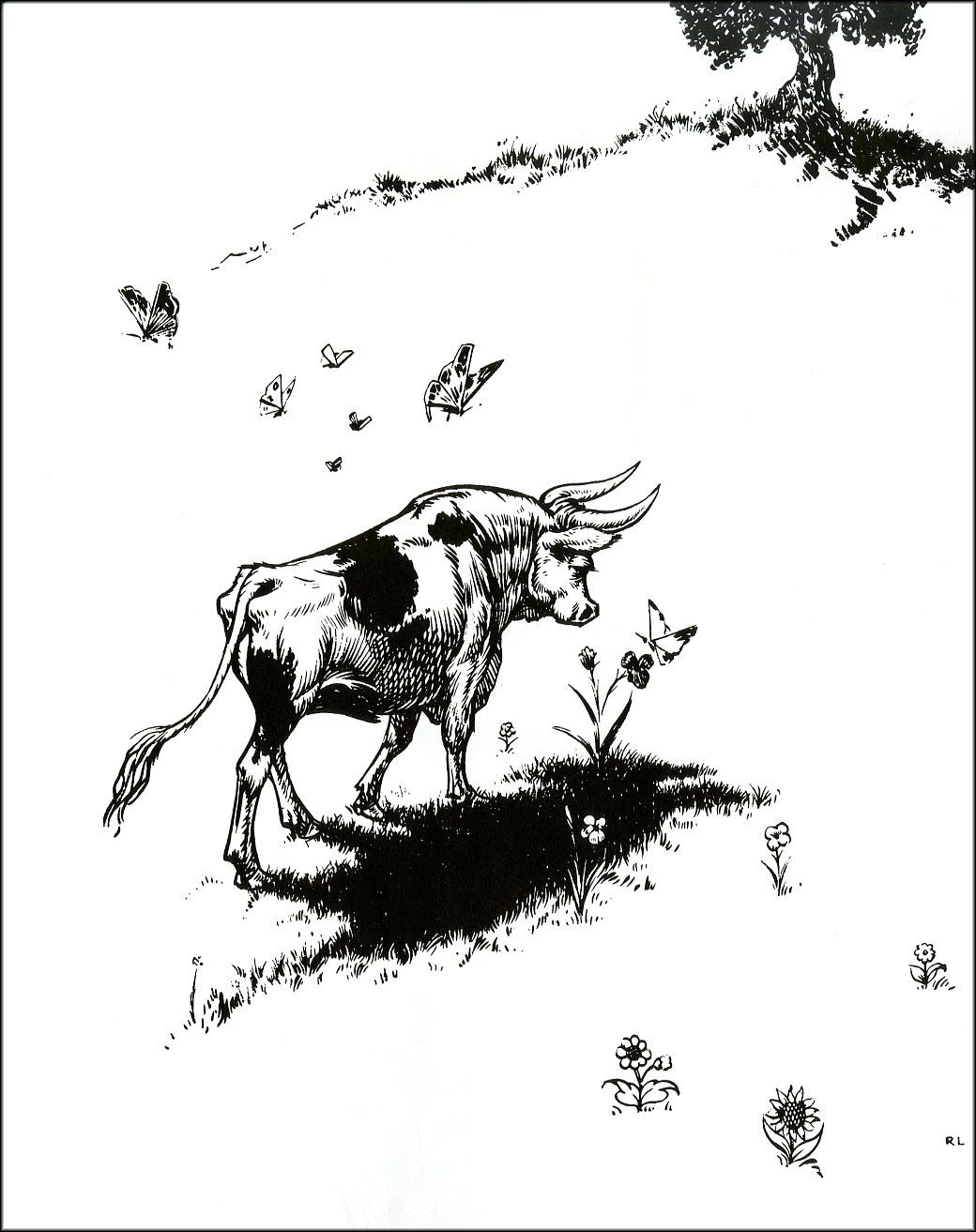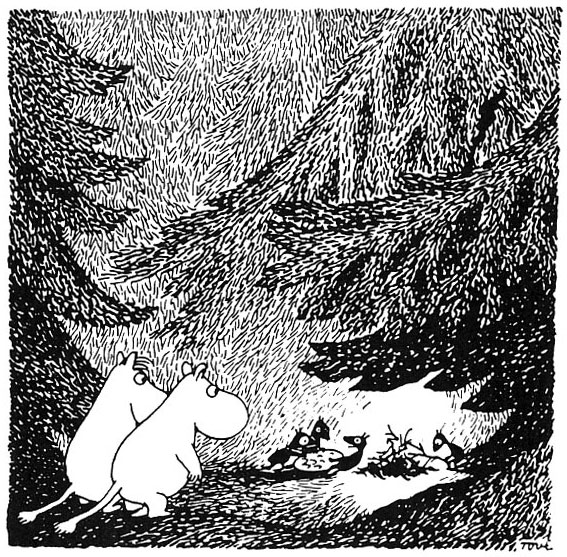Ever since Chris Van Allsburg’s birthday last month, we’ve been feeling a surge of appreciation for the plethora of beautiful picture books in our lives. In fact, we think some of the loveliest illustrations we’ve ever seen have been in books (or maybe that’s just the association with a great story talking), so we decided to round up a few of the most beautiful children’s books — at least according to us. Keep in mind: we’re going for beauty, not iconic status — so Tenniel’s Alice drawings and a few other iconic, innovative illustrations, while dear to us, don’t make the cut. Leaf through our picks for the most mindblowingly beautiful picture books after the jump, and since we can only draw from our own personal knowledge and tastes, and we know there are scores upon scores of gorgeous children’s books out there (thank goodness), be sure to add any other favorites of yours to our list in the comments!
Wednesday, July 18, 2012
From Anita Silvey's Children's Book-a-Day Almanac

by Munro Leaf
Illustrated by Robert Lawson
On July 18, 1936, General Francisco Franco led an uprising of army troops in North Africa against the elected government of Spain. So began the Spanish Civil War, sometimes called “the first media war” because foreign correspondents and writers became involved—people like Ernest Hemingway and George Orwell. One would not expect this event to have much effect, at all, on American children’s books. By and large, children’s book publishing in the United States tends to be myopic, focusing inward rather than on world events.
However, timing is everything—in publishing, then and now. And the Spanish Civil War looms large as the defining publicity event for one of our classic picture books, The Story of Ferdinand. This seventy-page saga, illustrated with black-and-white drawings, began as something of a lark. Munro Leaf felt that bunnies and kittens had been done to death in picture books, and he wanted a more memorable protagonist—so he chose a bull. Robert Lawson, who also lived in New York City at the time, delighted in incorporating visual puns and references into his art. For this Depression Era book, their publisher Viking printed around 1,500 copies. But everyone involved in this creation had some pretty shocking surprises in store.
Because of the Spanish Civil War, people began to look for political messages in this story about a Spanish bull. Some thought it was Fascist, some Socialist, and some Communist. It was banned in Spain and in Germany as degenerate propaganda. But many opinion makers—including Franklin and Eleanor Roosevelt, Thomas Mann, H. G. Wells—rose to the book’s defense. When it comes to children’s books, any censorship attempt always sells a lot of books. As a society, we simply don’t want anyone telling us what our children should or should not read. The next year, eighty thousand copies were sold, and The Story of Ferdinand became a staple on the bestseller list.
Censorship can get books started, but not keep books going. What has sustained The Story of Ferdinand over the years is the wonderful interplay between the Leaf’s text and Robert Lawson’s art. The book does have a message—but not one about the Spanish Civil War. Pete Wentz of the rock group Fall Out Boys recently wrote about The Story of Ferdinand: “The book provides an amazing metaphor for how people can be. There’s something really honorable about following your own path and not doing what’s expected of you. When we recorded ‘From Under the Cork Tree,’ we experimented with different sounds. …When we are ninety years old and on our deathbeds, it will matter to us that at least we took chances and followed our own path.”
Seventy-five years after Munroe Leaf wrote The Story of Ferdinand, young readers still respond to its gentle humor, its advocacy of taking one’s own direction, and its happy ending. Just as Leaf and Lawson believed, the book tells the story of a bull that, in the end, was very happy.
Here’s a page from The Story of Ferdinand:

All the other bulls ran around snorting and butting, leaping and jumping so the men would think that they were very very strong and fierce and pick them.
Ferdinand knew that they wouldn’t pick him and he didn’t care. So he went out to his favorite cork tree to sit down.
Also recommended: Wee Gillis by Munro Leaf, illustrated by Robert Lawson
Originally posted July 18, 2011.
Labels:
Anita Silvey,
picture book,
Spanish Civil War
Michele and Storycraft, every Wednesday at the Hills Branch
Labels:
Hills Branch,
Michele,
programming,
Storycraft
Tuesday, July 17, 2012
Monday, July 9, 2012
Friday, July 6, 2012
Thursday, July 5, 2012
Lego Club!

Lego Club begins next Tuesday, July 10th! Kids ages 8 and up are invited to design and build their own creations using our Legos. Sign up for each session one week in advance through the Children's Calendar at http://www.wellesleyfreelibrary.org/ or call the Children's Department at 781-235-1610 ext 1108. This group is limited to 12 kids each week. Sponsored by the Friends of the Wellesley Free Libraries.
Around the World in 80 Books (give or take a few...) Middle School titles that span the globe...where will you go?
Children's librarian Rebecca Kinney, who is also a middle school librarian at Newton Country Day School of the Sacred Heart during the academic year, created this amazing clickable globe that gives lists of middle-school-appropriate books set in different regions around the world. Be an armchair traveller this summer and explore a few titles!
http://www.newtoncountryday.org/RelId/630595/ISvars/default/Around_the_World_in_80_Books.htm
http://www.newtoncountryday.org/RelId/630595/ISvars/default/Around_the_World_in_80_Books.htm
Monday, July 2, 2012
Moomins and the wonderful work of Tove Jansson

Tove Jansson is revered around the world as one of the foremost children's authors of the twentieth century for her illustrated chapter books regarding the magical worlds of her creation, the Moomins. The Moomins saw life in many forms but debuted to its biggest audience ever on the pages of the world's largest newspaper, the London Evening News, in 1954. The strip was syndicated in newspapers around the world with millions of readers in forty countries.
The Moomins are a tight-knit family-hippo-shaped creatures with easygoing and adventurous outlooks. Jansson's art is pared down and precise, yet able to compose beautiful portraits of ambling creatures in fields of flowers or on rock-strewn beaches that recall Jansson's Nordic roots. The comic strip reached out to adults with its gentle and droll sense of humor. Whimsical but with biting undertones, Jansson's observations of everyday life, including guests who overstay their welcome, modern art, movie stars, and high society, easily caught the attention of an international audience and still resonate today.
For more on Tove Jansson and her work, go to:
http://www.moomin.com/eng/
http://www.moomintrove.com/index.htm
Labels:
children's fiction,
Finland,
graphic novel,
Tove Jansson
Paddington!

Michael Bond recalls in his own words how Paddington first came into being:
"I bought a small toy bear on Christmas Eve 1956. I saw it left on a shelf in a London store and felt sorry for it. I took it home as a present for my wife Brenda and named it Paddington as we were living near Paddington Station at the time. I wrote some stories about the bear, more for fun than with the idea of having them published. After ten days I found that I had a book on my hands. It wasn’t written specifically for children, but I think I put into it the kind things I liked reading about when I was young."
Michael Bond sent the book to his agent, Harvey Unna, who liked it and after sending to to several publishers it was eventually accepted by William Collins & Sons (now Harper Collins). The publishers commissioned an illustrator, Peggy Fortnum, and the very first Paddington book "A Bear Called Paddington" was published on 13th October 1958.
In 1965, after writing several Paddington titles Michael Bond retired from his job as a cameraman with the BBC, a job he held for many years, in order to write full time.
Of Paddington himself Michael Bond says:
"The great advantage of having a bear as a central character is that he can combine the innocence of a child with the sophistication of an adult. Paddington is not the sort of bear that would ever go to the moon - he has his paws too firmly on the ground for that. He gets involved in everyday situations. He has a strong sense of right and wrong and doesn't take kindly to the red tape bureaucracy of the sillier rules and regulations with which we humans surround ourselves. As a bear he gets away with things. Paddington is humanised, but he couldn't possibly be 'human'. It just wouldn't work."
The Paddington books have sold more than thirty-five million copies worldwide and have been translated into over forty languages.
Michael Bond continues:
"I am constantly surprised by all the translations because I thought that Paddington was essentially an English character. Obviously Paddington-type situations happen all over the world."
"I bought a small toy bear on Christmas Eve 1956. I saw it left on a shelf in a London store and felt sorry for it. I took it home as a present for my wife Brenda and named it Paddington as we were living near Paddington Station at the time. I wrote some stories about the bear, more for fun than with the idea of having them published. After ten days I found that I had a book on my hands. It wasn’t written specifically for children, but I think I put into it the kind things I liked reading about when I was young."
How Paddington first came into being
Michael Bond sent the book to his agent, Harvey Unna, who liked it and after sending to to several publishers it was eventually accepted by William Collins & Sons (now Harper Collins). The publishers commissioned an illustrator, Peggy Fortnum, and the very first Paddington book "A Bear Called Paddington" was published on 13th October 1958.
What happened next
In 1965, after writing several Paddington titles Michael Bond retired from his job as a cameraman with the BBC, a job he held for many years, in order to write full time.
Of Paddington himself Michael Bond says:
"The great advantage of having a bear as a central character is that he can combine the innocence of a child with the sophistication of an adult. Paddington is not the sort of bear that would ever go to the moon - he has his paws too firmly on the ground for that. He gets involved in everyday situations. He has a strong sense of right and wrong and doesn't take kindly to the red tape bureaucracy of the sillier rules and regulations with which we humans surround ourselves. As a bear he gets away with things. Paddington is humanised, but he couldn't possibly be 'human'. It just wouldn't work."
The Paddington books have sold more than thirty-five million copies worldwide and have been translated into over forty languages.
Michael Bond continues:
"I am constantly surprised by all the translations because I thought that Paddington was essentially an English character. Obviously Paddington-type situations happen all over the world."

The Paddington Books
The very first Paddington book was "A Bear Called Paddington" which was published in the UK by William Collins (now Harper Collins) in 1958. Illustrated with pen and ink drawings by Peggy Fortnum, this title is a novel in eight chapters and is still available today. There are eleven further titles in this series, the most recent of which was published in 2008, exactly fifty years after the very first book. These are the stories which tell most of Paddington's adventures.
With the first year of publication, they are as follows:
By clicking on the titles you can read a brief synopsis of each of the stories.
In 1972 the first picture books for younger readers were published. These were illustrated by Fred Banbery and there were six titles in the series.
In the 1980's another series of picture books were introduced. These books were a smaller format and were illustrated by David McKee.
The most recent Paddington picture books to be published are those which have been beautifully illustrated by the American artist, R.W. Alley and, in addition to recent brand new titles, he has also re-illustrated many of the earlier picture books.
With the inclusion of a large number of acitivity and board books for very young children, in total there have been over 150 different Paddington books published since 1958. However,from a collector's point of view, the most valuable are the first editions of the original novels.
With the first year of publication, they are as follows:
- A Bear Called Paddington
- More About Paddington 1959
- Paddington Helps Out 1960
- Paddington Abroad 1961
- Paddington at Large 1962
- Paddington Marches On 1964
- Paddington at Work 1966
- Paddington Goes to Town 1968
- Paddington Takes the Air 1970
- Paddington on Top 1974
- Paddington Takes the Test 1979
- Paddington: Here and Now 2008
- Paddington Races Ahead 2012
By clicking on the titles you can read a brief synopsis of each of the stories.
In 1972 the first picture books for younger readers were published. These were illustrated by Fred Banbery and there were six titles in the series.
In the 1980's another series of picture books were introduced. These books were a smaller format and were illustrated by David McKee.
The most recent Paddington picture books to be published are those which have been beautifully illustrated by the American artist, R.W. Alley and, in addition to recent brand new titles, he has also re-illustrated many of the earlier picture books.
With the inclusion of a large number of acitivity and board books for very young children, in total there have been over 150 different Paddington books published since 1958. However,from a collector's point of view, the most valuable are the first editions of the original novels.
For much more about Paddington, go to http://www.paddingtonbear.com/home.html
Labels:
British,
children's fiction,
marmalade,
Michael Bond,
Paddington Bear
Subscribe to:
Posts (Atom)





